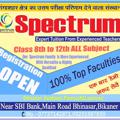Question 1 :
Neon and chlorine have atomic numbers $10$ and $17$ respectively. Their valencies will be ______ and ______ respectively.
Question 2 :
The statement that is not correct for periodic classification of element is
Question 4 :
The elements which exhibit both vertical and horizontal similarities are called:
Question 6 :
If Aufbau rule is not followed, $K-19$ will be placed in .................... block.
Question 7 :
Which of the following does not have valence electron in 3d-subshell?
Question 8 :
$965$ amp current is passed through molten metal chloride for one minute and $40$ seconds during electrolysis. The mass of metal deposited is $9gm$ at the cathode. The valency of metal atom (at.wt$=27$) is:
Question 9 :
An element 'A' forms a chloride $ACl_4$. The number electronic in the valence shell of 'A'. <br>
Question 10 :
The ratio of masses of oxygen and nitrogen of a particular gaseous mixture is 1 : 4. The ratio of number of their molecule is:
Question 16 :
When an element of very low ionisation potential is allowed to react with an element of very high electron affinity, we get:
Question 17 :
The ionisation energy of nitrogen is larger than that of oxygen because of
Question 18 :
Two ice cubes are pressed over each other and unite to form one cube. Which force is responsible for holding them together?
Question 19 :
The $+3$ ion of which one of the following has half-filled $4f $ subshell?<br/>
Question 21 :
One would expect the elemental form of <img style='object-fit:contain' src="https://storage.googleapis.com/teachmint/question_assets/NEET/5ea7f794a3d2442ab8292ccd"> at room temperature to be:
Question 24 :
A trend common to both group I and VII elements in the Periodic Table as atomic number increases is
Question 25 :
The statement that is true for the long form of the Periodic Table is
Question 28 :
In which of the following crystals of ionic compounds would you expect maximum distance between the centres of cations and anions
Question 29 :
When the first ionisation energies are plotted against atomic number, the peaks are occupied by
Question 31 :
Point out the wrong statement. On moving horizontally from left to right across a period in the Periodic Table
Question 33 :
The number of unpaired electrons in a paramagnetic diatomic molecule of an element with atomic number 16 is:
Question 35 :
The ionic radii of isoelectronic species <img style='object-fit:contain' src="https://storage.googleapis.com/teachmint/question_assets/NEET/5ea7f80ffdd8313cc87261b0"> are in the order?
Question 38 :
At ordinary temperature and pressure, among halogens, the chlorine is a gas, bromine is a liquid and iodine is a solid. This is because:
Question 41 :
The energy change accompanying the process given below is,<br> <img style='object-fit:contain' src="https://storage.googleapis.com/teachmint/question_assets/NEET/5ea7f843a3d2442ab8292e69">
Question 42 :
Which of the following phenomenon will occur when two atoms of same spin will react?
Question 44 :
The basis of keeping the elements in the groups of The Periodic Table is
Question 45 :
Which of the following is not the correct order for the stated property?
Question 46 :
<img style='object-fit:contain' src="https://storage.googleapis.com/teachmint/question_assets/NEET/5ea7f70da3d2442ab8292c5b"> has higher boiling point than expected, because :
Question 49 :
The correct order in which the first ionisation potential increases is
Question 50 :
Which one of the following statements is incorrect in relation to ionisation enthalpy?


























